Denise Sutherland's Blog, page 2
July 4, 2014
Code talkers
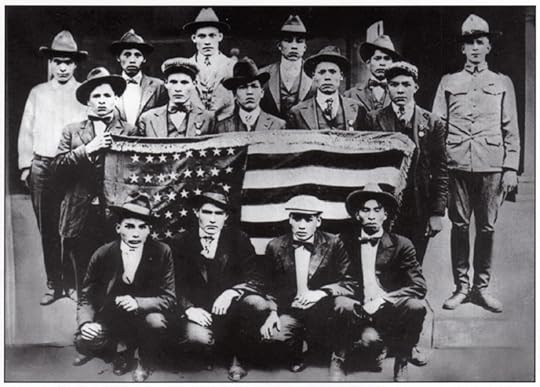
On 4th June this year, Chester Nez (93) died. He was the last of the Navaho code talkers.
In all the reading I've done on cryptography, codes, and ciphers, the story of the American Indian code talkers is my favourite.
Before we delve into their fascinating story, I need to be explain the difference between a code and a cipher.
CodesA code is a mapping of a word, a short phrase, or even a whole sentence, to a single collection of symbols (words, numbers, or other symbols). They are almost impossible to break through analysis. However, unless it's a very brief code (which can be memorised), a code requires a codebook. There is simply no way to remember all of the substitutions accurately (unless you have a photographic memory!). The existence of this codebook is a security hazard, though. If the enemy gets a copy, you've had it.
Some examples of codes are:
@! = the contract has been signed
pancake = come at once, bring syrup
169 = the plan is proceeding as set
whittle = all is lost, flee!
CiphersA cipher operates on individual symbols. It is an algorithm, and once the algorithm has been set, there is no need for a codebook, which is definitely a plus. But they are more prone to being cracked.
The simplest ciphers are substitution ciphers. A=1, B=2, C=3, or even A=?, B=%, C=@. This sort of cipher is easy to crack using letter frequency analysis — the knowledge that in English, E is the most common letter, THE and AND and the most common 3-letter words, and so on. These ciphers are the base of most cryptogram puzzles.
More complex ciphers have been developed, naturally, with all sorts of horrendously complicated tricks and turns. There is a whole cryptography field, after all. But in essence, a cipher is potentially crackable.
 SIGABA machineThe machine ciphers of the World War II were particularly difficult to crack, but with luck and the incredible skill of code breakers, it did happen. The German Enigma machines were just one type of many. The complex British Typex and American SIGABA cipher machines remained unbroken throughout the war.
SIGABA machineThe machine ciphers of the World War II were particularly difficult to crack, but with luck and the incredible skill of code breakers, it did happen. The German Enigma machines were just one type of many. The complex British Typex and American SIGABA cipher machines remained unbroken throughout the war.Code talkersTransmitting secure military messages during wartime, without the other side listening in, was (and still is) a major concern.
Native American languages were impenetrable to outsiders, as they had no Asian or European connections. This feature was turned into a 'codebook-free' code by the military. The invisible codebook resided in the Native Americans' native tongues. Code talking was pioneered by a handful of Cherokee and Choctaw Indians during WWI.
Many Indian tribes were recruited during both world wars — six tribal groups in WWI and 13 in WWII. The Navahos in WWII were by far the biggest group, with around 420 code talkers. The Navaho were preferred partially because no German students had infiltrated their culture after WWI, under the guise of studying their culture (as they had done with many other Indian tribes) – and therefore no outsiders had knowledge of their language.
The code talkers needed to memorise quite a lot of code words, but they would only need to memorise that A = Ant, Battleship = Whale, September = Half, and so on — because the hardest part, translating each of the code words into their native tongue, was second nature for them!

Before trusting American military secrets to the Navaho code talkers, they were trialled through Navy Intelligence, to see if the top American code breakers could decipher any of the messages. They reported that the Navaho language was 'a weird succession of gutteral, nasal, tongue-twisting sounds ... we couldn't even transcribe it, much less crack it.' (The Code Book, Singh, pg 196)
An alphabet was developed, from A for Ant in Navaho (WOL-LA-CHEE), to Z for Zinc (BESH-DO-TLIZ). There were up to three variations for the commonly used letters too — so Oil, Onion and Owl all encoded the letter O. This was instituted to stop the Japanese from being able to use frequency analysis if they realised some words were being spelt out. By cycling through variations on these common letters, any frequency analysis would be foiled.
Plenty of the words had direct translation into Navaho — so the English word 'dawn' was translated directly into the Navaho word for 'dawn' (HA-YELI-KAHN).
However, many terms didn't have equivalences in Navaho. To save time in spelling each word out, memorable phrases in Navaho were used instead:
Cemetery = among devils (JISH-CHA)
Tank destroyer = tortoise killer (CHAY-DA-GAHI-NAIL-TSAIDI)
Subordinate = helping each other (AL-KHI-NAL-DZL)
Farm = fox arm (MAI-BE-HE-AHGAN)
Dispatch = dog is patch (LA-CHAI-EN-SEIS-BE-JAY)
There were special names for all the various military craft and personnel.
Dive Bomber = Chicken Hawk (GINI)
Battleship = Whale (LO-TSO)
Colonel = Silver Eagle (ATSAH-BESH-LE-GAI)
And countries:
Japan = Slant Eye BEH-NA-ALI-TSOSIE
Australia = Rolled Hat (after the hats worn by our Diggers) (CHA-YES-DESI)
While their radio messages were intercepted by the enemy, they were never deciphered. A great rarity! "Lieutenant General Seizo Arisue, the Japanese chief of intelligence, admitted that, although they had broken the American Air Force code, they had failed to make any impact on the Navaho code." (The Code Book, Singh, pg 201)
You can see the full list of the code talker's dictionary here — information the Japanese and Germans would have literally killed for once upon a time! And this video is just one of many that tells more of their story:
There is a great discussion about Navaho code talkers in The Code Book by Simon Singh, if you want to discover more, and learn more about cryptography in general. There are also several books dedicated to the subject, including Chester Nez's personal account.
Published on July 04, 2014 17:04
July 1, 2014
25 Worst Spelling Words
Oh, English. Why you so crazy?
 Well, largely because a lot of English isn't English. It's been nicked from pretty much any other language. There are no standard spelling rules. And some words come from people's names (eponyms) — for example, diesel is from Rudolf Diesel, who invented the diesel engine. What chance have we got?
Well, largely because a lot of English isn't English. It's been nicked from pretty much any other language. There are no standard spelling rules. And some words come from people's names (eponyms) — for example, diesel is from Rudolf Diesel, who invented the diesel engine. What chance have we got?
For a lot of these hard words, French is the language of origin. French spelling, with a lot of letters that aren't pronounced, and profligate vowels, really trips us up badly.
I'm lucky in that I am a very 'visual' speller ... I spell easily, and can tell by looking at a word if it's misspelt. But the following words trip me up, almost always. And I'm sure I'm not alone!
Without further ado, here are my all time most hated least favourite words, that trip me up frequently. American spelling is in brackets.
Nastiest Spelling Words
acquiesceaneurysm (aneurism)auxiliarybureaucracycartilagechauvinismcoerciondachshunddesiccatediarrhoea (diarrhea)fluorescentfuchsiahaemorrhage (hemorrhage)hors d'oeuvreidiosyncrasyjeopardise (jeopardize)likelihoodmasseuseminusculeparaphernaliaplagiarise (plagiarize)prerogativereminiscentsilhouettevariegatedSo anything I have to write about minuscule dachshunds with variegated fluorescent fuchsia hors d'oeuvres is just a nightmare, I tell you!
Spelling tips
If you want to learn these nastiest of spelling words, so you can impress your friends and family — and tear less hair out — then these tips may help.Try to memorise them. Write the word down, repeatedly. Say it over and over in your head. Spell it out loud. Try for one word every day or twoCome up with a memorably silly or weird sentence as a mnemonic (another hard word!). As a teenager I remembered to spell unfortunately as 'un-for-tuna-tely', imagining a tuna fish watching TV (I bet it would love Jeremy Wade's shows). And I still use this mnemonic today.Try pronouncing the word as written, which reminds you of its spelling — so dachshund could become 'da-ch-sh-und'. If you'd like even more tricky spelling words to practice, check out my article over on English Language Skills!
 Well, largely because a lot of English isn't English. It's been nicked from pretty much any other language. There are no standard spelling rules. And some words come from people's names (eponyms) — for example, diesel is from Rudolf Diesel, who invented the diesel engine. What chance have we got?
Well, largely because a lot of English isn't English. It's been nicked from pretty much any other language. There are no standard spelling rules. And some words come from people's names (eponyms) — for example, diesel is from Rudolf Diesel, who invented the diesel engine. What chance have we got?For a lot of these hard words, French is the language of origin. French spelling, with a lot of letters that aren't pronounced, and profligate vowels, really trips us up badly.
I'm lucky in that I am a very 'visual' speller ... I spell easily, and can tell by looking at a word if it's misspelt. But the following words trip me up, almost always. And I'm sure I'm not alone!
Without further ado, here are my all time most hated least favourite words, that trip me up frequently. American spelling is in brackets.
Nastiest Spelling Words
acquiesceaneurysm (aneurism)auxiliarybureaucracycartilagechauvinismcoerciondachshunddesiccatediarrhoea (diarrhea)fluorescentfuchsiahaemorrhage (hemorrhage)hors d'oeuvreidiosyncrasyjeopardise (jeopardize)likelihoodmasseuseminusculeparaphernaliaplagiarise (plagiarize)prerogativereminiscentsilhouettevariegatedSo anything I have to write about minuscule dachshunds with variegated fluorescent fuchsia hors d'oeuvres is just a nightmare, I tell you!
Spelling tips
If you want to learn these nastiest of spelling words, so you can impress your friends and family — and tear less hair out — then these tips may help.Try to memorise them. Write the word down, repeatedly. Say it over and over in your head. Spell it out loud. Try for one word every day or twoCome up with a memorably silly or weird sentence as a mnemonic (another hard word!). As a teenager I remembered to spell unfortunately as 'un-for-tuna-tely', imagining a tuna fish watching TV (I bet it would love Jeremy Wade's shows). And I still use this mnemonic today.Try pronouncing the word as written, which reminds you of its spelling — so dachshund could become 'da-ch-sh-und'. If you'd like even more tricky spelling words to practice, check out my article over on English Language Skills!
Published on July 01, 2014 16:16
June 29, 2014
Nixie Clues #4 - Answers
And now for the big reveal — answers, with explanations, for the latest set of clues. The definitions are underlined.
1. Shame about poison for humans (4,7) = HOMO SAPIENS. Anagram (indicated by about) of SHAME + POISON.
2. Row of bushes missing first side (4) = EDGE. This is a deletion clue. Row of bushes = HEDGE. Missing first = remove the first letter (H). Which leaves you EDGE.
3. Citrus Mole misbehaving in post office (6) = POMELO. An anagram, indicated by misbehaving. The fodder is MOLE + PO (for post office).
4. American city’s sample of tomahawks (5) = OMAHA. A hidden word clue, indicated by sample of. It's in clear view, inside tomahawks.
5. Khan plays test in Uzbek capital (8) = TASHKENT. An anagram (indicated by plays) of KHAN + TEST.
6. Adhesive from grated tapes (5) = PASTE. An anagram (grated) of TAPES.
How did you get on?
1. Shame about poison for humans (4,7) = HOMO SAPIENS. Anagram (indicated by about) of SHAME + POISON.
2. Row of bushes missing first side (4) = EDGE. This is a deletion clue. Row of bushes = HEDGE. Missing first = remove the first letter (H). Which leaves you EDGE.
3. Citrus Mole misbehaving in post office (6) = POMELO. An anagram, indicated by misbehaving. The fodder is MOLE + PO (for post office).
4. American city’s sample of tomahawks (5) = OMAHA. A hidden word clue, indicated by sample of. It's in clear view, inside tomahawks.
5. Khan plays test in Uzbek capital (8) = TASHKENT. An anagram (indicated by plays) of KHAN + TEST.
6. Adhesive from grated tapes (5) = PASTE. An anagram (grated) of TAPES.
How did you get on?
Published on June 29, 2014 17:32
June 26, 2014
Nixie Clues #4
 Image courtesy of dan | FreeDigitalPhotos.netI've finally got a new set of (easy) cryptic clues for you to solve. Just the thing for a chilly winter's day. So get a cup of hot <insert favourite hot beverage name here>, and a pen, and let me know how you get on!
Image courtesy of dan | FreeDigitalPhotos.netI've finally got a new set of (easy) cryptic clues for you to solve. Just the thing for a chilly winter's day. So get a cup of hot <insert favourite hot beverage name here>, and a pen, and let me know how you get on!Shame about poison for humans (4,7)Row of bushes missing first side (4)Citrus Mole misbehaving in post office (6)American city’s sample of tomahawks (5)Khan plays test in Uzbek capital (8)Adhesive from grated tapes (5)I will post the answers, with explanations, on Monday morning. Please don't give away the answers in your comments, just say 'I got it!' or similar — thanks :)
Published on June 26, 2014 16:03
June 22, 2014
The dawn of jigsaw puzzles
 I don't know about you — but there's only so many words I can take. I wrote Word Searches For Dummies on a challenging deadline. (Actually — let's face it, all my Dummies books were written on 'challenging deadlines'. Hmmm.) My brain was getting a bit melty from all the words ... but jigsaws saved me. I kept a jigsaw next to my computer, and took regular short breaks to work on it.
I don't know about you — but there's only so many words I can take. I wrote Word Searches For Dummies on a challenging deadline. (Actually — let's face it, all my Dummies books were written on 'challenging deadlines'. Hmmm.) My brain was getting a bit melty from all the words ... but jigsaws saved me. I kept a jigsaw next to my computer, and took regular short breaks to work on it.It got me out of my chair, away from the screen, and thinking of something other than word searches. A bit of visual fun and thinking, rather than endless wordy stuff. I got through at least three large jigsaws while writing the book, including an almost impossible one of Escher's Relativity drawing.
Nowadays there are squillions (it is so a word) of jigsaws. They may have a few simple pieces or multi-thousand pieces. 3D shaped puzzles. Jigsaws without straight edge pieces. Jigsaws with 'extra pieces'. Double sided jigsaws. Online jigsaws. All white jigsaws! How did we get to this alarming point?
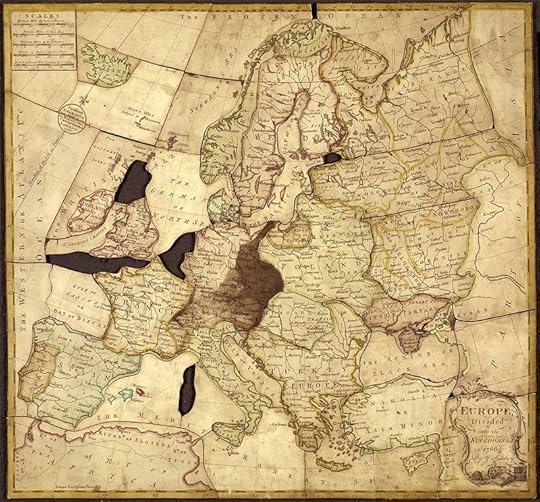 The first jigsaw puzzle, by John Spilsbury 1766
The first jigsaw puzzle, by John Spilsbury 1766British LibraryPeople have, naturally, been playing around with images for thousands of years, and mosaic art could possibly be seen as a type of early jigsaw.
But the first true jigsaw, where a picture is cut up with the intention of being put back together, is credited to engraver and map maker John Spilsbury. He started with his 'dissected map' of the British Empire around 1766. He quickly moved on to include maps of other regions. The maps were glued to wood, and pieces were cut around the shapes of the countries. These dissections were used as a teaching aid for the children from wealthy families. You can find out more about the first jigsaw on the British Library website.
Sadly John died young, so his idea passed on to others to develop. The popularity of dissections grew in the 1800s. They were mostly maps, cut along country borders, with an educational focus. After 1820, the subject of dissections also moved on to religious and moral teaching for children. And around this time some more daring types started to make non-educational (gasp) puzzles, with scenes from fairy takes and nursery rhymes. For fun (gasp again).
In 1880 the treadle saw invented, and the puzzles then came to be known as jigsaws, rather than dissections. Which was admittedly a pretty uninspiring name ...
Initially all jigsaws were wooden, but eventually cardboard was used, by the late 1800s. Cardboard was a popular material once die cutters were developed (like large, complicated and excessively sharp cookie cutters). With the move to cardboard, jigsaws became more affordable to all and sundry, the 'target age' was expanded to include everyone, not just kids, and their popularity exploded:
New York Times headline from May 1908 warns:
NEW PUZZLE MENACES THE CITY'S SANITY ; Young and Old, Rich and Poor, All Hard at Work Fitting Cut-Up Pictures Together. SOLITAIRE IS FORGOTTEN Two Clergymen, a Supreme Court Justice, and a Noted Financier Among the Latest Converts to the Craze.
A lady writing to The Australiasian, from London in 1909 wrote "I do not fancy that the "Jigsaw" will have a lengthy life. Doubtless, it will soon be banished to the limbo of departed games, as "diabolo" was banished."1
Even royalty got in on the act. The Queensland paper, The Warwick Examiner and Times (July 1910) reported that "The late King Edward was bitten by the craze, and was admitted to be one of the speediest puzzle solvers in England, having beaten all records by producing a complicated picture in the space of five minutes. At every house-party to which he went, the hostess made a point of having a good supply of Jig-Saws for his especial benefit."2
The Golden Age of jigsaws was during the 1920s and 1930s. They were especially popular during the Depression, proving to be an inexpensive entertainment for families, that could be done by many people, pulled apart once completed, passed around, reused and shared.
In the mid-1930s manufacturers started to include a picture of the finished puzzle on the cover of the box. Jigsaw 'loaning libraries' were set up, and jigsaw parties, with prizes for the fasting solving times, were popular.
Over time, the designs of what we now think of as the 'classic' jigsaw pieces were developed. There are many sorts of puzzle shapes, though, from colour line cutting (cutting along the edges of a shape, like with the dissected maps, cutting along the edges of countries) to special figure pieces (which can be shaped like animals, people, letters, numbers, and so on). This article goes into detail about the cutting techniques on old jigsaws.
And nowadays there are so many new designs and ways of doing jigsaws ... but that's a story for another time! But it's clear that the Lady who wrote from London in 1909, predicting a short life for these enjoyable puzzles, was way off!
If you are really into jigsaws, I can recommend reading the book The Jigsaw Puzzle: Piecing Together a History , by Anne D. Williams.
_______________________________________________________________________________
1 A LADY'S LETTER FROM LONDON. (1909, May 15). The Australasian (Melbourne, Vic. : 1864 - 1946), p. 47. Retrieved June 20, 2014, from http://nla.gov.au/nla.news-article1396933442 "JIG-SAW" PUZZLES. (1910, July 2). Warwick Examiner and Times (Qld. : 1867 - 1919), p. 2. Retrieved June 20, 2014, from http://nla.gov.au/nla.news-article82296732a
Published on June 22, 2014 22:11
June 17, 2014
Gemini Cryptic 7014
Here is my analysis of the Gemini Cryptic Crossword from Monday 16 June edition of The Canberra Times. The definition is underlined (except in cryptic definition and double definition clues).
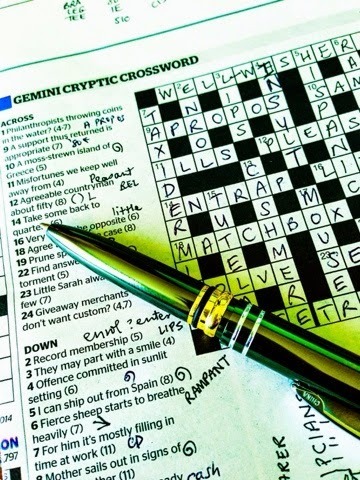 ACROSS
ACROSS1. Philanthropists throwing coins in the water? (4-7) WELL-WISHERS
Cryptic definition.
9. A support this returned is appropriate (7) = APROPOS
A charade clue with a reversal — A + PROP (support) + OS (this returned = SO reversed).
10. A moss-strewn island of Greece (5) = SAMOS
Anagram (strewn) of a moss.
11. Misfortunes we keep well away from (4) = ILLS
Cryptic definition. We keep well by staying away from ills!
12. Agreeable countryman about fifty (8) = PLEASANT
Container clue — PEASANT (countryman) gets put about (or around) L (fifty, in Roman numerals).
14. Take some back to quarters (6) = ENTRAP
Reversal and charade. Some (PART) goes back to become TRAP. And it also goes on the back of quarters = EN (east and north).
16. Very much the opposite (6) = LITTLE
Cryptic definition. The opposite of very much.
18. Agree to fight the case (8) = MATCHBOX
Charade. Agree can be a verb meaning MATCH, and fight = BOX (also as a verb).
19. Prune spruce (4) = TRIM
Double definition. They're not really completely different meanings of the word, though.
22. Find answer to love's torment (5) = SOLVE
Anagram of loves, indicated by torment.
23. Little Sarah always gets in a few (7) = SEVERAL
Container. A little or short version of Sarah = SAL (although I don't know of any Sarahs who use Sal as a nickname — I've always thought Sal as a short version of Sally. Anyway. I'm sure they exist somewhere!) So, always gets in means EVER is put inside SAL. SEVERAL.
24. Giveaway merchants who don't want custom? (4,7) = FREE TRADERS
Cryptic definition.
DOWN
2. Record membership (5) = ENROL
Double definition, of sorts.
3. They may part with a smile (4) = LIPS
Cryptic definition.
4. Offence committed in sunlit setting (6) = INSULT
Anagram of sunlit, indicated by setting.
5. I can ship out from Spain (8) = HISPANIC
Anagram of I can ship, indicated by out.
6. Fierce sheep starts to breathe heavily (7) = RAMPANT
Charade. RAM = sheep, and PANT = starts to breathe heavily.
7. For him it's mostly filling in time at work (11) = TAXIDERMIST
Cryptic definition. These can be hard to get until you have more letters filled in, in the grid.
8. Mother sails out in signs of similar weather (11) = ISOTHERMALS
Anagram of mother sails, indicated by out.
13. Fabric obtained for ready money only (8) = CASHMERE
Charade. CASH (ready money) + MERE (only).
15. In France you change later for protection (7) = TUTELAR
Charade + anagram. You, in France = TU. An anagram of later (indicated by change) = TELAR. I wasn't familiar with this word: TUTELAR is an adjective meaning 'serving as a protector, guardian or patron'. I'm not sure the form of the word protection is strictly correct here, as that's the noun form, and strictly speaking, it ought to be an adjective, the same as the answer.
17. Cat lands us in more trouble (6) = MOUSER
Container + anagram. Put us inside (in) an anagram (trouble) of more.
20. Two kings embracing are not seen so often (5) = RARER
Container. Two kings indicates two abbreviations for kings, R (Latin for king = Rex), in this case. And they're embracing, or going around, are, which is in the clear = R(ARE)R.
21. Keen to upset a singer (4) = AVID
Reversal. A singer might be a DIVA. And when upset, or reversed, this gives us AVID.
How did you get on?
Published on June 17, 2014 15:28
June 16, 2014
Train wreck?
Well, moving house (no we haven't unpacked all the boxes yet, shut up), followed by two indexing jobs ( Income Contingent Loans , and Born Bad ) in close succession kind of occupied all my attention and energy for a few months there. My apologies!
I had a train trip to Sydney in April, and was amused by this crossword in the 'in train' magazine, The Link.

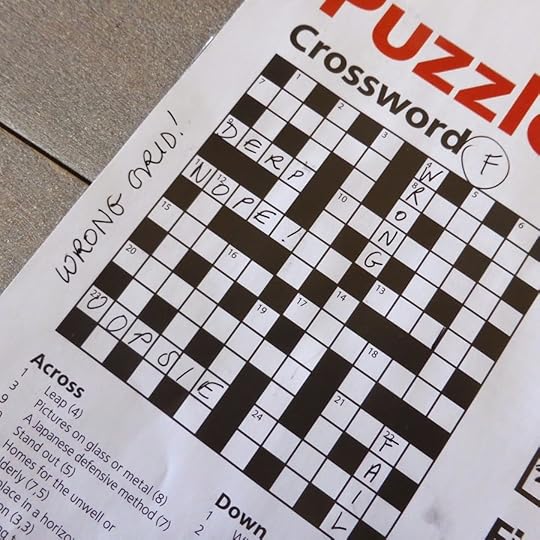
1 Across is supposedly a 4 letter word for 'leap' ... except in the grid it's 1 Down, and there isn't a 1 Across ... and so on. I'm sure the setter was well and truly pissed off to find out the designer put the wrong grid in with the clues (or vice versa)!
Published on June 16, 2014 18:45
March 9, 2014
Moving
Published on March 09, 2014 14:32
February 24, 2014
Cookbook Indexing
My goodness, what happened to the last month?
Well, what happened was an indexing job. These tend to be very intense, on a short deadline, and don't leave much time or mental energy for anything else.
I've just written a double index for a vegan cookbook, Edible , by Angela Flack. As the book is roughly half recipes, and half nutritional & health information, I wrote two indexes. One is a recipe index, and the other is a topic index.
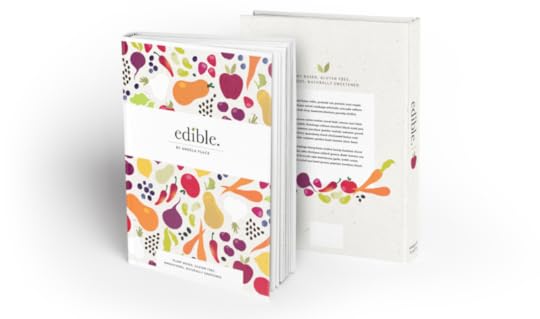
When indexing cookbooks, it's important to keep in mind that there are two sorts of people using the book.
The first group are people who haven't used the book before, so they don't know the names of recipes. They need to be able to search on main or unusual ingredients ... I've got a bunch of chia seeds here, what can I make with them?
For these readers, it's important to list any given recipe in several places, as a subheading under main/unusual ingredients. An example from the book :
mushrooms
Mussaman Curry, 167
sweet potatoes
Mussaman Curry, 167
It also needs to be listed under types of recipes, as a reader might be searching for something to make for dinner :
main dishes
Mussaman Curry, 167
curries
Mussaman Curry, 167
The second group of people are those who've used the cookbook a fair bit, and know the name of the recipe they want to make. For these readers, it's important to include the name of the recipe in full, as is.
It needs to be listed under its full name, in alphabetical order:
.
Mussaman Curry, 167
Mustard Madness (dressing), 73
.
So, in most cases, a recipe will appear at least twice in a cookbook index, and sometimes even 5 or 6 times, depending on the number of main or unusual ingredients.
And that's a little tiny bit about cookbook indexing! Now you know!
Published on February 24, 2014 13:59
January 14, 2014
Gemini Cryptic 6860
It's been a while since I dissected a Gemini Cryptic; here's the first one for 2014 ...
This one appeared in the Monday 13 January issue of The Canberra Times. The Gemini Cryptic is a British cryptic, set by two people. More detail here. As ever, the definition is underlined (except in double and cryptic definition clues).
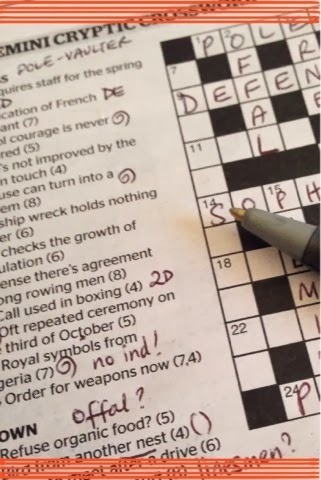 ACROSS
ACROSS1) He requires staff for the spring (4-7) = POLE-VAULTERCryptic definition. Nothing to do with hiring people, this guy needs a pole to spring up with!
9) Vindication of French miscreant (7) = DEFENCECharade clue. Of French = DE ('of' in French) + FENCE (a miscreant, as in someone who received stolen goods).
10) Cool courage is never shattered (5) = NERVEAnagram (shattered) of never.
11) She's not improved by the golden touch (4) = LILYCryptic definition. Reference to 'gild the lily' and a girl's name.
12) In use can turn into a problem (8) = NUISANCEAnagram (turn into) of in use can.
14) A ship wreck holds nothing for her (5) = SOPHIAAnagram (wreck) of a ship + O (nothing). Her is the definition, indicating (a little unfairly) any girl's name.
16) It checks the growth of population (6) = CENSUSCryptic definition. Nothing to do with prophylactics or population control, but checking as in recording!
18) Sense there's agreement among rowing men (8) = EYESIGHTContainer clue. You need some knowledge of rowing as a sport to get this one! Agreement inside (among) rowing men = YES in EIGHT.
19) Call used in boxing (4) = RINGDouble definition. Call someone on the phone, or ring them. And a boxing ring.
22) Oft repeated ceremony on the third of October (5) = TRITEThe third of October = T. The third letter of October, get it? With RITE (ceremony) tacked on.
23) Royal symbols from Algeria (7) = REGALIAAnagram of Algeria. This clue is unfair, as there is no anagram indicator. A fairer version would be something like Royal symbols from Algeria in disarray.
24) Order for weapons now (7,4) = PRESENT ARMSCryptic definition.
DOWN
2) Refuse organic food? (5) = OFFALCryptic definition. Refuse is a noun here, meaning stuff that's thrown away, rather than the verb.
3) Bird from another nest (4) = ERNEHidden word, in another nest. A bird that mainly resides in crosswords nowadays, ERNE is a literary term for the sea eagle.
4) Place to meet after a drive (6) = AVENUECharade clue. VENUE (place to meet) after A.
5) They call out at court? (8) = LINESMENAn apt clue to appear during the Australian Open ... cryptic definition, referring to the tennis court, not a legal court!
6) Jobs for the boys? (7) = ERRANDSAnother cryptic definition. Errands being small jobs you might get boys to run for you (if you're lucky!)
7) Young people arranged to see Scotland (11) = ADOLESCENTSAnagram (arranged) of see Scotland.
8) It's selected by a backer (7,4) = REVERSE GEARCryptic definition. Not a financial backer, but someone who is driving backwards!
13) They share an item in a geometry set (8) = DIVIDERSDouble definition. People who share are those who divide things up. And dividers are a measuring compass, often seen in geometry sets at school.
15) PM has about a thousand in support (7) = PREMIERContainer clue. Put RE (about) + M (thousand) in PIER (support).
17) Greek ferry operator (6) = CHARONSlightly cryptic definition. Greek mythology. Refers to Charon, the old man who ferried souls into Hades, across the Rivers Styx and Acheron.
20) Mails sorted out for the Muslim world (5) = ISLAMAnagram (sorted out) of mails.
21) Site of beautiful marble mausoleum in Panama graveyard (4) = AGRAThis clue gets the 'longest definition' prize for this crossword! Hidden word clue, the answer is in Panama graveyard. Agra is where the Taj Mahal is located.
Published on January 14, 2014 16:34




